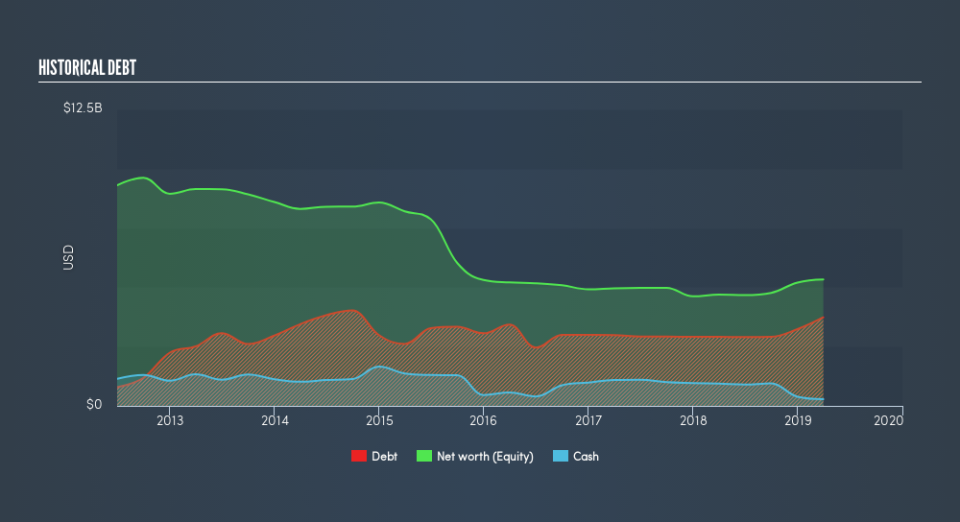Is Murphy Oil Corporation's (NYSE:MUR) Balance Sheet Strong Enough To Weather A Storm?

Want to participate in a short research study? Help shape the future of investing tools and you could win a $250 gift card!
While small-cap stocks, such as Murphy Oil Corporation (NYSE:MUR) with its market cap of US$4.2b, are popular for their explosive growth, investors should also be aware of their balance sheet to judge whether the company can survive a downturn. Evaluating financial health as part of your investment thesis is crucial, since poor capital management may bring about bankruptcies, which occur at a higher rate for small-caps. We'll look at some basic checks that can form a snapshot the company’s financial strength. Nevertheless, this is not a comprehensive overview, so I’d encourage you to dig deeper yourself into MUR here.
Does MUR Produce Much Cash Relative To Its Debt?
MUR has built up its total debt levels in the last twelve months, from US$2.9b to US$3.7b , which accounts for long term debt. With this growth in debt, MUR currently has US$286m remaining in cash and short-term investments , ready to be used for running the business. Additionally, MUR has generated cash from operations of US$1.3b over the same time period, resulting in an operating cash to total debt ratio of 35%, indicating that MUR’s current level of operating cash is high enough to cover debt.
Can MUR meet its short-term obligations with the cash in hand?
Looking at MUR’s US$1.6b in current liabilities, the company has been able to meet these obligations given the level of current assets of US$2.6b, with a current ratio of 1.61x. The current ratio is calculated by dividing current assets by current liabilities. For Oil and Gas companies, this ratio is within a sensible range since there's a sufficient cash cushion without leaving too much capital idle or in low-earning investments.
Can MUR service its debt comfortably?
MUR is a relatively highly levered company with a debt-to-equity of 70%. This is somewhat unusual for small-caps companies, since lenders are often hesitant to provide attractive interest rates to less-established businesses. No matter how high the company’s debt, if it can easily cover the interest payments, it’s considered to be efficient with its use of excess leverage. A company generating earnings before interest and tax (EBIT) at least three times its net interest payments is considered financially sound. In MUR's case, the ratio of 3.93x suggests that interest is appropriately covered, which means that lenders may be inclined to lend more money to the company, as it is seen as safe in terms of payback.
Next Steps:
MUR’s high cash coverage means that, although its debt levels are high, the company is able to utilise its borrowings efficiently in order to generate cash flow. This may mean this is an optimal capital structure for the business, given that it is also meeting its short-term commitment. Keep in mind I haven't considered other factors such as how MUR has been performing in the past. I recommend you continue to research Murphy Oil to get a better picture of the small-cap by looking at:
Future Outlook: What are well-informed industry analysts predicting for MUR’s future growth? Take a look at our free research report of analyst consensus for MUR’s outlook.
Valuation: What is MUR worth today? Is the stock undervalued, even when its growth outlook is factored into its intrinsic value? The intrinsic value infographic in our free research report helps visualize whether MUR is currently mispriced by the market.
Other High-Performing Stocks: Are there other stocks that provide better prospects with proven track records? Explore our free list of these great stocks here.
We aim to bring you long-term focused research analysis driven by fundamental data. Note that our analysis may not factor in the latest price-sensitive company announcements or qualitative material.
If you spot an error that warrants correction, please contact the editor at editorial-team@simplywallst.com. This article by Simply Wall St is general in nature. It does not constitute a recommendation to buy or sell any stock, and does not take account of your objectives, or your financial situation. Simply Wall St has no position in the stocks mentioned. Thank you for reading.

 Yahoo Finance
Yahoo Finance 
